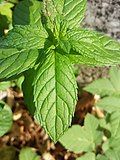Note: This is a project under development. The articles on this wiki are just being initiated and broadly incomplete. You can Help creating new pages.
Mentha spicata
Mentha spicata is native to Europe and southern temperate Asia, extending from Ireland in the west to southern China in the east. It is naturalized in many other temperate parts of the world, including northern and southern Africa. It is used as a flavouring in food and herbal teas. The aromatic oil, called oil of spearmint, is also used as a flavouring and sometimes as a scent.
Uses
Parts Used
Chemical Composition
The main constituents were carvone (40.8% ± 1.23%) and limonene (20.8% ± 1.12%), followed by 1,8-cineole (17.0% ± 0.60%), β-pinene (2.2% ± 0.25%), cis-dihydrocarvone (1.9% ± 0.49%), and dihydrocarveol (1.7% ± 0.31%). [1]
Common names
| Language | Common name |
|---|---|
| Kannada | |
| Hindi | Pahari Pudina |
| Malayalam | |
| Tamil | |
| Telugu | |
| Marathi | NA |
| Gujarathi | NA |
| Punjabi | NA |
| Kashmiri | NA |
| Sanskrit | |
| English | Spearmint, Garden mint, Lamb mint |
Properties
Reference: Dravya - Substance, Rasa - Taste, Guna - Qualities, Veerya - Potency, Vipaka - Post-digesion effect, Karma - Pharmacological activity, Prabhava - Therepeutics.
Dravya
Rasa
Guna
Veerya
Vipaka
Karma
Prabhava
Habit
Identification
Leaf
| Kind | Shape | Feature |
|---|---|---|
| Simple | Elliptical | 5–9 cm (2–3 1⁄2 in) long and 1.5–3 cm (1⁄2–1 1⁄4 in) broad, with a serrated margin. The stem is square-shaped, a defining characteristic of the mint family of herbs. |
Flower
| Type | Size | Color and composition | Stamen | More information |
|---|---|---|---|---|
| Unisexual | 2.5–3 mm (0.098–0.118 in) long | Pink or white in colour | Spearmint flowers in the summer (from July to September in the northern hemisphere), and has relatively large seeds, which measure 0.62–0.90 mm (0.024–0.035 in). |
Other features
List of Ayurvedic medicine in which the herb is used
Where to get the saplings
Mode of Propagation
How to plant/cultivate
Spearmint leaves can be used fresh, dried, or frozen. They can also be preserved in salt, sugar, sugar syrup, alcohol, or oil. The leaves lose their aromatic appeal after the plant flowers. [3]
Commonly seen growing in areas
Photo Gallery
References
External Links
- Ayurvedic Herbs known to be helpful to treat Fevers
- Ayurvedic Herbs known to be helpful to treat Headaches
- Ayurvedic Herbs known to be helpful to treat Digestive disorders
- Herbs with Leaves used in medicine
- Herbs with common name in Hindi
- Herbs with common name in English
- Habit - Herb
- Index of Plants which can be propagated by Seeds
- Herbs that are commonly seen in the region of Garden area
- Herbs
- Lamiaceae




